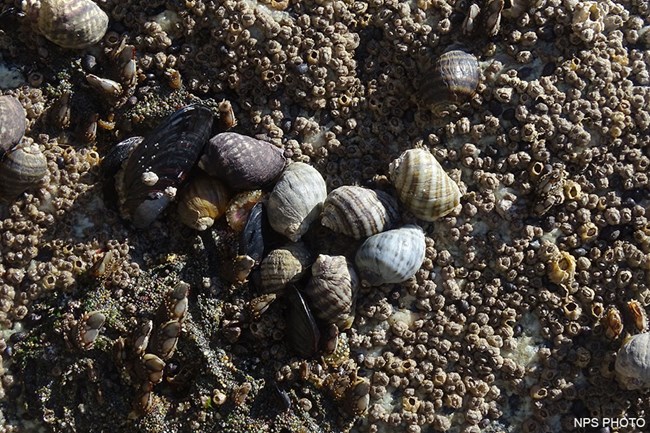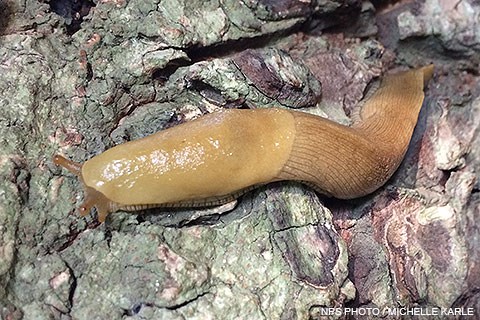
The phylum Mollusca is large and diverse, encompassing ten different classes of animals. The animals are most commonly recognized as one of three different types: the bivalves, the univalves, and those without shells (or with very small internal shells, ex. slugs). Bivalves are mollusks with two shells such as clams and oysters. Univalves are animals with one shell such as a snail. Mollusks without shells include squid, banana slugs, and octopi. Some mollusks are terrestrial, occurring in most environments on earth, while others live in the water for some or all of their life. Many of the most popular mollusks are marine species because they are pretty and some are caught for food or jewelry. Some of the qualities that define a mollusk are definite organs (mainly heart, gonads, and kidneys), a complete digestive tract, and a muscular foot. Although their bodies are not segmented, they do have two definable parts: the head and the foot. Their shells are made of calcium carbonate. The shells are very decorative on the inside for many marine species, and the outside for many snails. Most mollusks have at least two stages of life and their second stage (or adult phase) is often marked by bearing a shell. ChitonsPolyplacophora are more commonly referred to as chitons. They look ancient, like a trilobite of the ocean. Their body is an elongated dome with eight overlapping plates and they are usually as big as a quarter. Making their living on algae, they are commonly found in intertidal areas as they cling to the rocks, but usually they are camouflaged very well with cryptic coloring. 
BivalvesThose animals with two shells are conveniently all lumped together in class Bivalvia. They don’t have a formal eating structure, so they filter food by siphoning it from the water with gills between their two valves. Their organs, including their nervous system, are all located between the two shells and they have a muscular foot that can stick out. This foot is used for locomotion, attaching to rocks, or both. Bivalvia is diverse and includes animals like the oyster, which give us pearls by covering bits of sand that come into their system with the calcium carbonate that they use for their shells. The waters surrounding Point Reyes are a popular spot for collecting clams, mussels, and oysters. Check our Fishing page and Marine Life Protection Act page for more information on where collecting bivalves is permitted, harvest limits, and for information about the annual mussel quarantine. Tusk ShellsThe class Scaphopoda are known as tusk shells and found in marine environments world wide. They look like elephant tusks that are 15cm long, and they feed on the bottom of the sea. Most likely, these animals occur at our Seashore, but the chances of seeing them are extremely unlikely. 
GastropodsGastropoda is the most widespread class within Mollusca. It is estimated to have as many as 75,000 species and undoubtedly many of its species occur at Point Reyes. The gastropods are univalve animals and can be terrestrial, freshwater, or marine and include snails, abalones, limpets. Their name is from Greek roots with gaster referring to stomach and poda referring to feet. This makes sense because their major two body parts are their head region (with most of their organs) and their muscular foot. This separation also comes from a process which also defines a gastropod called torsion. Torsion occurs during their development into an adult; their internal organs twist 180 degrees and results in the separation of its organs from its foot. Although the gastropods have some similarities, they are for the most part extremely varied and because they all live in very different places, they eat very different things. The banana slug is one of the most commonly spotted Gastropods at Point Reyes. 
The abalone is by far most famous specimen of Gastropoda at Point Reyes. It is a beautiful marine snail that at one time was extremely abundant along the coast. Black abalone is one of seven abalone species found in California's intertidal waters. Commercial fisheries for black abalones began in 1968, and by the 1990s, landings had plummeted to almost zero. But fishing wasn't the only culprit. Black abalone populations have been severely depleted by withering syndrome. This disease, caused by a bacterial infection, halts the abalone's production of digestive enzymes. No longer able to digest food, the abalone must consume its own body mass. The disease was first recognized in the mid-1980s and has since decimated black abalone populations by up to 99% in some regions. As a result, black abalones have been classified as critically endangered by the International Union for the Conservation of Nature. As a result of the deplete populations, there are currently (as of 2020) very stringent restrictions on the collection of abalones in northern California. Learn more about withering syndrome in the Multimedia section below and about regulations for harvesting abalone on California Fish and Wildlife's Ocean Sport Fishing Regulations website. CephalopodsMost intelligent and softest are the easiest way to describe the cephalopods. The creatures of Cephalopoda have lost their shells, and compensate with a far more developed brain. Also, they have an overdeveloped muscular foot, which is turned into arms or tentacles. Its flagship members are octopus, squid, cuttlefish, and nautilus. Besides being able to make a living in difficult places, they are able to defend themselves in unusual ways. Most are able to change color and texture rapidly to match surroundings, and are also able to shoot an ink cloud to make a getaway. Point Reyes Seashore has the red octopus (Octopus rubescens), but like may inhabitants of the sea, it is almost never seen. They do live in intertidal areas, but spotting one is extremely rare and if you do, it is safest to not touch the animal. Another common cephalopod is the common squid, but don't expect to see this one either. They only will come towards the shore area to breed and then die. Text for this page was primarily written by Kristen Truchinski. Multimedia PresentationsFrom 2007 to 2012, Pacific Coast Science and Learning Center Science Communication Interns produced a series of podcasts, videos, and audio-slide shows exploring science from Bay Area national parks. Two of these The Natural Laboratory multimedia products focused on mollusks—one on Olympia oysters and one on the Humboldt squid. Listen to the podcasts below. Visit our Multimedia Presentations: The Natural Laboratory Audio Podcasts page for additional podcasts.
Additional ReadingLeskiw, D. 2020. Holding Fast, Or Failing? There are dozens of confounding elements working against abalone recovery on the California coast. Earth Island Journal 35(1): 18–25. Available at https://earthisland.org/journal/index.php/magazine/entry/holding-fast-or-failing-abalone-california/ (accessed 26 August 2020). |
Last updated: September 19, 2024
